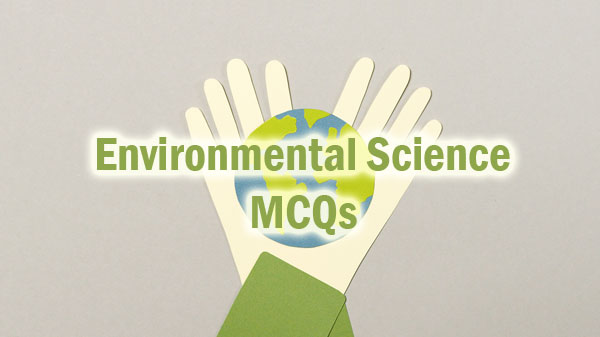Environmental Studies Quiz
Download all Environmental Studies Quiz Papers here. We are providing Environment Science Quiz Papers. We have given the solutions for EVS solved Quiz Papers to make your preparation efficient. Click here to Download the Environment Science Quiz Papers from the attached pdfs.

EVS Quiz Papers attached in the PDF Format so the aspirants can download quickly. Along with these Environmental Studies Quiz papers, we have attached Environment Science Syllabus and Exam Pattern. Environmental Studies Quiz Papers are available. Applicants can download EVS Quiz Papers.
Also, get the Study material, Preparation tips in addition to the EVS Quiz Papers for posts. On our page, we provide Environmental Studies Quiz Papers for the sake of aspirants.
Quiz on Environmental Studies
1. According to second law of thermodynamics …………………… .
(A) Every energy transfer is 100% efficient
(B) No energy transfer is 100% efficient
(C) Energy transfer enriches next trophic level in energy content
(D) Energy transfer could increase more than 100% energy in an ecosystem
2. The atmosphere takes up moisture from water bodies (lakes, rivers and oceans) through …………………… .
(A) Condensation
(B) Evaporation
(C) Precipitation
(D) Infiltration
3. Normal pressure of the atmosphere at mean sea level is …………………… .
(A) 1000 hpa
(B) 1013.2 hpa
(C) 1020 hpa
(D) 1000.2 hpa
4. Maximum concentration of ozone in the atmosphere occurs at/in :
(A) Near ground
(B) Mesosphere
(C) Upper stratosphere
(D) Lower stratosphere
5. Wind rose diagram of a station gives ……………… .
(A) Frequency of extreme wind speeds
(B) Frequency of wind speeds of different ranges
(C) Frequency of wind from different directions in different speed ranges
(D) Frequency of wind from different directions
6. Which of the following radionuclides is present in human body ?
(A) I–131
(B) Zn–65
(C) Co–60
(D) C–14
7. 100 mg of NaCl dissolved in 100 mL water represents how many ppm ?
(A) 1000
(B) 1.0
(C) 10
(D) 100
8. 10% transmittance of a solution on colorimeter indicates an absorbance of …………………… .
(A) 2
(B) 1
(C) 0.1
(D) 0.2
9. How much is the permissible limit of arsenic in drinking water ?
(A) 10 mg/lit
(B) 1 mg/lit
(C) 10 μg/lit
(D) 1 μg/lit
10. Mineral matter in soil is approximately …………………… .
(A) 10%
(B) 25%
(C) 40%
(D) 30%
11. The interlocking network of transfer of food from one trophic to another can be explained using :
(A) Food-chain
(B) Food-web
(C) Detritus cycle
(D) Exchange pool
12. Western Ghats mountain range is called as ecological hot spot because :
(A) Number of plants is high
(B) Number of animals is high
(C) Number of plants and animals is high
(D) Number of species of biota is high
13. There are more/varied and specialized niche found in :
(A) Alage
(B) Pteridophytes
(C) Plants
(D) Animals
14. A series of orderly changes that occurs in nature over the time and space is known as :
(A) Ecological succession
(B) Ecological degradation
(C) Decline in number of species
(D) Increase parasites
15. Liquid based formulation of biofertilizer are designed for :
(A) Soil application through drip irrigation
(B) Aerial application
(C) Seed application
(D) Root application
16. ‘Avalanche’ are a result of which of the following ?
(A) Earthquakes beneath the ocean floor
(B) Pressure differentials on the equator
(C) Pollution of mountainous regions
(D) Unstability of ice-capped hilly terrains (glaciers)
17. ‘Silica oozes’ are located at which of the following sites ?
(A) Meandering river beds
(B) Deep sea floors
(C) Lake deposits
(D) River banks
18. The excessive rains/droughts, caused due to El Nino, are prominently observed along …………………… .
(A) coasts of Peru and Chile
(B) eastern coastal belt of South America
(C) eastern coastal belt of India
(D) eastern coastal regions of Japan
19. Which of the following is associated with the phosphorous cycle of the earth ?
(A) Trade winds
(B) Guano
(C) Photosynthesis
(D) Evaporation of water
20. The hazardous surface effects of an earthquake are due to …………………… .
(A) Primary waves
(B) Secondary waves
(C) ‘L’ waves
(D) shear waves
21. Maximum permissible dose of radiation for worker is :
(A) 5 rem/year
(B) 2 rontgen/year
(C) 1 rontgen/year
(D) 2 rem/year
22. How much nuclear energy is released per fission of U-235 ?
(A) 1000 keV
(B) 100 keV
(C) 200 meV
(D) 500 MeV
23. Nearly …………………… % of solar energy is in the infrared region of the solar spectrum.
(A) 46
(B) 30
(C) 78
(D) 25
24. Arrange them in decreasing order of their pollution potential :
(A) Natural gas, coal, petroleum
(B) Coal, petroleum, natural gas
(C) Petroleum, coal, natural gas
(D) Natural gas, petroleum, coal
25. There are different stages in the biomethanation of waste. Which of the following involves methane generation ?
(A) Aceticlastic
(B) Acetogenic
(C) Acidogenesis
(D) Hydrolysis
26. The water sample for D.O. analysis is fixed at the site itself because :
(A) D.O. increases in transit
(B) The D.O. depletes due to microbial activity
(C) Suspended solids increase in transit
(D) The dissolved solids increase during transport
27. Acidification of soil has been reported from various parts of the country which is caused due to :
(A) use of organic fertilizers
(B) excess and long term use of inorganic fertilizers
(C) practice of crop rotation
(D) controlled irrigation
28. O3 pollution is indicated by plant leaves in the form of :
(A) Intercoastal bronzing
(B) Minute chlorotic dots
(C) Tip and margin browning
(D) Watery film on epidermis
29. Mangroves are ecologically important because :
(A) They are evergreen in nature
(B) They function as nursery for many marine organisms
(C) They harbour mosquitoes
(D) They provide fodder to grazing cattle
30. Noise pollution during festivals is considered to be high, when it exceeds :
(A) 30 dB
(B) 70 dB
(C) 110 dB
(D) 150 dB
31. Driving force behind the formulation of the Environmental (Protection) Act, 1986 adopted by Govt. of India was :
(A) UN Conference on Human Environmental, Stockholm 1972
(B) UN Conference on global climate change
(C) Doha Declaration
(D) UN Conference Environment and Development, Rio
32. Which impacts of developmental activities are not susceptible to mitigation measures ?
(A) Reversible
(B) Adverse
(C) Positive
(D) Irreversible
33. The impact identification in EIA brings together …………………. .
(A) Project characteristics and baseline information
(B) Project characteristics and mitigation measures
(C) Baseline information and impacts
(D) Impacts and mitigation measures
34. Strategic environmental impact assessment is applicable for ………………. .
(A) Industrial projects
(B) Mining projects
(C) Infrastructural projects
(D) Policy, plan or program
35. Environmental inventory enlists ……………….. as it exists in nature.
(A) Total environmental assets
(B) Affected environmental assets
(C) Partial environmental assets
(D) Flora and Fauna
36. Ramsar UN Convention is to protect and conserve ……………………… .
(A) Wetlands
(B) Grasslands
(C) Tropical forests
(D) Wildlife
37. The Act, which gave the Government and Forest Department the power to create Reserve Forests in India, is ……………………… .
(A) Indian Forest Act of 1927
(B) Forest Conservation Act of 1980
(C) Wildlife Protection Act of 2002
(D) The Environment Act of 1986
38. Which of the following categories of Bio-medical waste is considered as ‘Hazardous waste category No. 1’ ?
(A) Microbial waste
(B) Biotechnological waste
(C) Human anatomical waste
(D) Discarded medicines
39. An Act related to biodiversity is known as :
(A) The Biological Diversity Act 2002
(B) The Biodiversity Act 2002
(C) The Plant and Animal Diversity Act 2002
(D) The Forest Biodiversity Act 2002
40. ………………. does not come under the applicability of Environment (Protection) Act, 1986, which is related to hazard waste management and handling.
(A) Bio-medical waste
(B) Radio-active waste
(C) River pollution due to agricultural practices
(D) Domestic waste
41. Arithmetic mean, geometric mean and harmonic mean are equal if and only if :
(A) all observations are positive
(B) all observations are distinct
(C) all observations are in ascending order
(D) all observations are equal
42. For the binomial distribution :
(A) Mean < variance
(B) Mean = variance
(C) Mean > variance
(D) Mean and variance have no definite relationship
43. Probability of an event must be :
(A) Positive
(B) between 0 and 1
(C) small
(D) less than 1
44. The purpose behind studying models of population growth is to :
(A) predict the population size
(B) identify dominating species
(C) identify endangered species
(D) compare similarities and differences between environ- mental conditions
45. The problem of acid rain is caused due to presence of higher concentration of ……………. in air over industrial area.
(A) CO
(B) CO2
(C) O3
(D) SO2/SO3
46. Goitre is caused due to :
(A) Excess of iodine
(B) Deficiency of iodine
(C) Excess of chlorine
(D) Deficiency of chlorine
47. Agenda 21 is a blue-print for sustainable development and was issued at the end of UN Conference on Environment and Development held at :
(A) Stockholm
(B) Rio de Janeiro
(C) Johannesburg
(D) Kyoto
48. Which of the following refers to efforts for controlling ozone depletion ?
(A) Kyoto protocol
(B) Ramsan convention
(C) Montreal protocol
(D) CITES convention
49. Coupling of cyanobacteria cultivation in the nutrient rich effluents with decomposition of organic matter can minimise release of green house gases. It is due to all of the following, except :
(A) Autotrophic nature
(B) Ability to fix nitrogen
(C) Ability to deplete nutrients
(D) Heterotrophic nature

